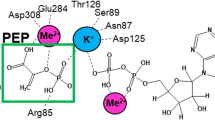Summary
The mechanism of activation by inorganic phosphate and ATP of cardiac muscle pyruvate kinase was studied with the aid of steady-state kinetics. The enzyme was purified to homogeneity to a final specific activity of 400 units/ mg (phosphate buffer, pH 7.6, 25 °C). At pH 7.6 the enzyme displays Michaelis-Menten kinetics with respect to both its substrates, phosphoenolpyruvate and ADP. Substrate kinetic constants are: app.Km(phosphoenolpyruvate) −0.04 mM, app.Km(ADP) =0.22 mM. Under the conditions used in the standard assay the specific activity is greatly enhanced by inorganic phosphate (50 mM) or ATP (2.5 mM). Each of these modifiers, acting separately, increases the Vmax without seriously affecting Michaelis constants and Hill coefficients. In the presence of both Pi and ATP, only a decrease in Vmax was observed.
The kinetics of activation by inorganic phosphate of pyruvate kinase was examined. Studying the effect of varying concentrations of Pi on the initial rate we obtained a hyperbolic saturation curve with the app. Km(Pi) = 20 mM and Vmax = 167 units/ mg. The evidence is presented that inorganic phosphate is a substrate for a side reaction catalyzed by cardiac pyruvate kinase. It is shown that in the presence of pyruvate, inorganic phosphate and ATP in the assay system, Pi is incorporated into acid-labile products of this reaction, inorganic pyrophosphate being one of them.
These findings indicate the existence of an alternative reaction catalyzed by pyruvate kinase by which energy may be stored in the form of inorganic pyrophosphate.
Similar content being viewed by others
Abbreviations
- PEP:
-
phosphoenolpyruvate
- Pi:
-
inorganic phosphate
- TEA:
-
triethanolamine
- EDTA:
-
ethylenediaminetetraacetate
References
Baranowska B, Baranowski T: Mol Cell Biochem 45: 117–125, 1982.
Koster JF, Hulsman WC: Arch Biochem Biophys 141: 98–101, 1970.
Abbe K, Yanada T: J Bacteriol 149: 299–305, 1982
Buecher T, Pfleiderer G: In: SP Colowick, NO Kaplan (eds), Methods in Enzymology, Academic Press, New York, 1955, Vol 1, pp 435–440.
Parkinson J, Easterby JS: Biochim Biophys Acta 481: 471–480, 1977.
Tietz A, Ochoa S: Arch Biochem Biophys 78: 477–493, 1958.
Author information
Authors and Affiliations
Rights and permissions
About this article
Cite this article
Baranowska, B., Terlecki, G. & Baranowski, T. The influence of inorganic phosphate and ATP on the kinetics of bovine heart muscle pyruvate kinase. Mol Cell Biochem 64, 45–50 (1984). https://doi.org/10.1007/BF00420927
Received:
Issue Date:
DOI: https://doi.org/10.1007/BF00420927




